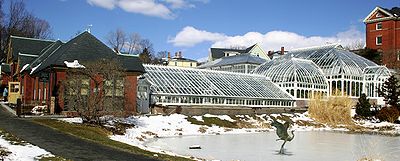
The Botanic Garden of Smith College
Encyclopedia
The Botanic Garden of Smith College is located on the campus of Smith College
, in Northampton, Massachusetts
, USA
. It consists of a fine selection of woody trees, shrubs, herbaceous plants, and an excellent collection of warm-weather plants in a set of historic conservatories. All are open to the public.
 The first outlines of the Botanic Garden began in the 1880s, when Smith College hired the firm of Olmsted, Olmsted and Eliot to develop a campus landscape plan. Frederick Law Olmsted
The first outlines of the Botanic Garden began in the 1880s, when Smith College hired the firm of Olmsted, Olmsted and Eliot to develop a campus landscape plan. Frederick Law Olmsted
, senior member of the firm, is best remembered for designing Central Park
in New York City and the Boston park system. The Olmsted plan dated February 1893 includes curving drives and walkways, open spaces with specimen trees, and vistas over Paradise Pond through wooded groves. Olmsted also provided planting lists of diverse trees, shrubs, herbs, and aquatic and marsh plants. However in a more formal sense, the Botanic Garden of Smith College took shape under William Francis Ganong
, appointed professor of botany and director of the Botanic Garden in May 1894, and Edward J. Canning, hired in summer 1894 as head gardener.
Smith's Botanic Garden collection includes 1200 types of woody trees and shrubs, 2200 types of hardy herbaceous plants, 3200 types of tender herbaceous and woody plants in greenhouses, and 6600 different kinds of plants, giving a total of approximately 10,000 types of plants on campus.
 The Lyman Conservatory's greenhouses with 12,000 square feet (1,100 m²) date from 1895, and house over 2500 species of plants for the instruction of Smith students in the plant sciences. These plants are selected from a wide variety of families and habitats; they comprise one of the best collections of tropical, subtropical, and desert plants in the country.
The Lyman Conservatory's greenhouses with 12,000 square feet (1,100 m²) date from 1895, and house over 2500 species of plants for the instruction of Smith students in the plant sciences. These plants are selected from a wide variety of families and habitats; they comprise one of the best collections of tropical, subtropical, and desert plants in the country.
The campus arboretum consists of 127 acres (514,000 m²) of woody trees and shrubs, and is free and open every day.
Other Smith Campus Gardens include the Rock Garden, Japanese Garden, President's Garden, Capen Garden, Woodland Garden, Mary Maples Dunn Garden, and Systematics Garden & Perennial Border.
Smith College
Smith College is a private, independent women's liberal arts college located in Northampton, Massachusetts. It is the largest member of the Seven Sisters...
, in Northampton, Massachusetts
Northampton, Massachusetts
The city of Northampton is the county seat of Hampshire County, Massachusetts, United States. As of the 2010 census, the population of Northampton's central neighborhoods, was 28,549...
, USA
United States
The United States of America is a federal constitutional republic comprising fifty states and a federal district...
. It consists of a fine selection of woody trees, shrubs, herbaceous plants, and an excellent collection of warm-weather plants in a set of historic conservatories. All are open to the public.

Frederick Law Olmsted
Frederick Law Olmsted was an American journalist, social critic, public administrator, and landscape designer. He is popularly considered to be the father of American landscape architecture, although many scholars have bestowed that title upon Andrew Jackson Downing...
, senior member of the firm, is best remembered for designing Central Park
Central Park
Central Park is a public park in the center of Manhattan in New York City, United States. The park initially opened in 1857, on of city-owned land. In 1858, Frederick Law Olmsted and Calvert Vaux won a design competition to improve and expand the park with a plan they entitled the Greensward Plan...
in New York City and the Boston park system. The Olmsted plan dated February 1893 includes curving drives and walkways, open spaces with specimen trees, and vistas over Paradise Pond through wooded groves. Olmsted also provided planting lists of diverse trees, shrubs, herbs, and aquatic and marsh plants. However in a more formal sense, the Botanic Garden of Smith College took shape under William Francis Ganong
William Francis Ganong
William Francis Ganong, M.A., Ph.D., LL.D., F.R.S.C., was a Canadian botanist, historian and cartographer. His botany career was spent mainly as a professor at Smith College in Northampton, Massachusetts...
, appointed professor of botany and director of the Botanic Garden in May 1894, and Edward J. Canning, hired in summer 1894 as head gardener.
Smith's Botanic Garden collection includes 1200 types of woody trees and shrubs, 2200 types of hardy herbaceous plants, 3200 types of tender herbaceous and woody plants in greenhouses, and 6600 different kinds of plants, giving a total of approximately 10,000 types of plants on campus.

The campus arboretum consists of 127 acres (514,000 m²) of woody trees and shrubs, and is free and open every day.
Other Smith Campus Gardens include the Rock Garden, Japanese Garden, President's Garden, Capen Garden, Woodland Garden, Mary Maples Dunn Garden, and Systematics Garden & Perennial Border.

